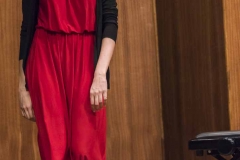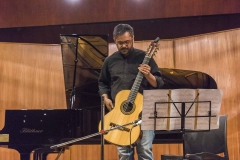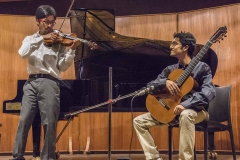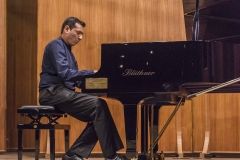by Kuldeep Barve
Today’s Adda was dedicated to listening to orchestral music. Continuing the discussion, here are some wonderful videos which are good introductions to the orchestra
Benjamin Britten’s ‘Young Persons Guide to the Orchestra’
https://www.youtube.com/watch?v=KhOEIwNM3e0
Sergei Prokofiev’s ‘Peter and the Wolf’ recited by David Bowie
https://www.youtube.com/watch?v=kpoizq-jjxs&list=PL5A4871BCD99ABE5F
A set of videos about the different orchestral instruments
Igor Stravinsky’s ‘THE RITE OF SPRING’
Why are we listening to the Rite of Spring?
The Rite of Spring or ‘Le Sacre du Printemps’, composed by Igor Stravinsky is considered one of the most important compositions in the Western Classical tradition. It was written for a ballet, a production by the famous ‘Ballet Russe’ under the direction of Sergei Diaghilev. This piece was composed around 1913, at a time when not only western classical music, but the art world in general was going through a major transition. Impressionism in France, various nationalistic styles emerging in Russia, Hungary, etc., and atonal music of Schoenberg are few of the instances of this transition. Romanticism was breathing its last breath.
Looking back, we can also situate these changes in a broader social context; society was itself going through massive changes. The age old empires and the aristocracy were challenged and a new order seemed apparent. The Russian revolution was around the corner and so was the first world war.
All this is just a very brief background on the times, but that is not the reason why this piece is important. The Rite of Spring, from the time when it was performed for the first time in Paris, where it provoked and scandalised the audience, has grown in importance as a monumental piece of music with staying power. Listening to it today, more than a hundred years later, it still is as powerful and effervescent. Bernstein, in his small portrait of Stravinsky, says that in his music, we can hear the Russian tradition of Scriabin, Rimsky Korsakov (Stravinsky’s teacher) but also Debussy and Ravel. Although, it was difficult to take for audiences then, Bernstein says looking back Stravinsky’s music that it is deeply entrenched in tonality, in Russian folk traditions (partly this came from composers like his teacher Rimsky Korsakov, Mussorgsky etc.). This is an aspect which I find very relevant today. We all come from a rich and diverse country like India and we should not overlook the vast melodic, rhythmic and structural possibilities which we can draw upon.
What to listen for in the The Rite of Spring?
The piece is one of the most sophisticated pieces but manages to stay completely raw in its sonority. It reminds one of primitive rituals, earthy smells and vivid colour. Spring, which is a season of change is what characterises this piece.
Structure and story (from wikipedia)
| Episode | English translation | Synopsis[n 1] | |
| Part I: L’Adoration de la Terre (Adoration of the Earth)[9] | |||
| Introduction | Introduction | Before the curtain rises, an orchestral introduction resembles, according to Stravinsky, “a swarm of spring pipes [dudki]”[10] | |
| Les Augures printaniers | Augurs of Spring | The celebration of spring begins in the hills. An old woman enters and begins to foretell the future. | |
| Jeu du rapt | Ritual of Abduction | Young girls arrive from the river, in single file. They begin the “Dance of the Abduction”. | |
| Rondes printanières | Spring Rounds | The young girls dance the Khorovod, the “Spring Rounds”. | |
| Jeux des cités rivales | Ritual of the Rival Tribes | The people divide into two groups in opposition to each other, and begin the “Ritual of the Rival Tribes”. | |
| Cortège du sage: Le Sage | Procession of the Sage: The Sage | A holy procession leads to the entry of the wise elders, headed by the Sage who brings the games to a pause and blesses the earth. | |
| Danse de la terre | Dance of the Earth | The people break into a passionate dance, sanctifying and becoming one with the earth. | |
| Part II: Le Sacrifice (The Sacrifice)[9] | |||
| Introduction | Introduction | ||
| Cercles mystérieux des adolescentes | Mystic Circles of the Young Girls | The young girls engage in mysterious games, walking in circles. | |
| Glorification de l’élue | Glorification of the Chosen One | One of the young girls is selected by fate, being twice caught in the perpetual circle, and is honoured as the “Chosen One” with a martial dance. | |
| Evocation des ancêtres | Evocation of the Ancestors | In a brief dance, the young girls invoke the ancestors. | |
| Action rituelle des ancêtres | Ritual Action of the Ancestors | The Chosen One is entrusted to the care of the old wise men. | |
| Danse sacrale (L’Élue) | Sacrificial Dance | The Chosen One dances to death in the presence of the old men, in the great “Sacrificial Dance”. | |
Listen and note the following –
- The high register opening motif, played on the bassoon. This melody is drawn from a Russian folk tune.
- Stravinsky introduces all the main instruments and notice that the wind instruments are central to this piece. The bassoon, the clarinet, the english horn, the bass clarinet. The string section is used more as a rhythmic instrument as a whole. The timpani is also used a lot for rhythmic texture and drive. There are some unconventional instruments used as well.
- Notice how these instruments are playing different motifs and themes, and a rhythmic, primitive melodic mesh is created….imagine you are in a field or amidst nature in springtime.
- Listen for ostinatos. There are many places in the piece wherein Stravinsky sets up ostinatos
- Try and imagine different instrument groups representing different story themes or characters. For example, the bassoons are mimicking the village elders.
- Listen to the tension that created especially in the last part when the chosen girl is sacrificed
‘Keeping Score’, a documentary featuring Michael Tilson Thomas (conductor of the San Francisco Symphony), throws light on Stravinsky and the Russian Tradition.
This short film is a tribute to Igor Stravinsky by Leonard Bernstein:
All major composers have been influenced by Stravinsky in one way or the other. Here is Leo Brouwer, one of the most important composers for the guitar in the 20th century conducting his own ‘Concerto de Toronto’ written for guitar and orchestra with Jorge Caballero on guitar.
https://www.youtube.com/watch?v=Bfg3EdSqbvc
Most of the important composers for the guitar from the 1950s onwards have increasingly been writing for orchestra, other ensembles and film scores. It’s important that we listen to their non-guitar music as well to get a holistic understanding of the composer.
I feel that as Indians, we are exposed to a lot of rich music from our own traditions (either folk or classical or semi-classical) and western music in all its forms (folk, pop, rock, jazz, blues, classical, etc.). As musicians we should absorb this richness with open ears and hearts. At the same time, we should concentrate on our main instrument, the guitar and its repertoire.
An important aspect of being a musician is to be aware of what tradition the composer is coming from. Let’s say that you are playing a piece by Albeniz. It’s of utmost importance to read about Albeniz’s life, his times, his influences and other music by him. By ‘other music’, I mean the music he composed for other instruments as well. Most of Albeniz’s music played on the guitar was originally composed for the piano since Albeniz himself was a pianist. He was strongly influenced by traditional Spanish music and a lot of his works are indicative of that.
Please listen to this wonderful rendition of his ‘Mallorca’ played on the piano vis-a-vis played on the guitar.
Guitar rendition by John Williams
Notice the differences in the renditions, and while listening, remember that the piece was originally written for the piano!
To enrich our understanding of various orchestral colours and timbres and interpretative possibilities of the music that we play on the guitar, it is imperative that we listen to the composer’s works written for various instruments and orchestra.
Enjoy and let’s continue this discussion!























